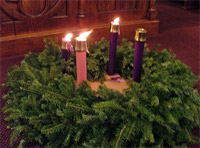by Steve Raml, Director of Liturgy & Music
Hopes and Fears
While the “commercial world” is hitting you hard with Halloween, we in the “Church world” are looking a bit further ahead, to Advent and Christmas. We enter the season of Advent this year on Sunday, December 1st. But just what are we entering into?

The season of Advent came into being toward the middle of the sixth century. Its orientation was entirely different from Lent, which was already well established as a season of repentance. At first, the Advent Season was determined as the six Sundays leading up to Christmas. Pope St. Gregory the Great reduced them to four, perhaps hoping to mark the difference more clearly between Advent and Lent.
Before the seventh century, Christmas was a secondary feast, especially in Rome. As it came to take on increased importance, Advent evolved in the same way, becoming more solemn. Also, its orientation changed. It started out as simply a time to prepare for Christmas but has taken on a double meaning.
The Roman Calendar describes Advent as “a season to prepare for Christmas when Christ’s first coming to us is remembered; as a season when that remembrance directs the mind and heart to await Christ’s Second Coming at the end of time.”
The Sunday liturgies celebrate this double perspective of Advent: waiting for the Second Coming of the Lord (First and Second Sundays) and the immediate preparation for the feast of Christmas (Third and Fourth Sundays). As the Catechism of the Catholic Church says, “When the Church celebrates the liturgy of Advent each year, she makes present the ancient expectancy of the Messiah, for by sharing in the long preparation for the Savior’s first coming, the faithful renew their ardent desire for His Second Coming.” (CCC #524)
Through our Advent Liturgy, we share in the longing and preparation for the coming of the Messiah by the first Chosen People. This in turn helps us to long for, and be prepared for, Christ’s Second Coming. The carol we will sing on Christmas Eve, “O Little Town of Bethlehem,” says it well: “the hopes and fears of all the years are met in Thee tonight.”
Advent is a time of reflection and looking within ourselves, not to find our faults, but to get in touch with and take hold of our dreams, our hopes and yes, even our fears. What are our hopes and dreams for the future of our family, our world, our church, our lives? How can we participate in God’s plan for the future?
We can reflect on those questions daily in the Advent season by taking part in a long-standing Catholic tradition: the Advent wreath. Lighting candles each evening, perhaps at our dinner time, is a perfect time to pause in prayer.
While the Advent wreath is firmly entrenched in our Catholic sensibility today, it was not always “Catholic.” There is evidence of pre-Christian Germanic & Scandinavian peoples using wreathes with lit candles during the cold & dark December days as a sign of hope in the future warm & extended-sunlight days of spring. By the Middle Ages, Christians adapted this tradition and Advent wreathes became part of the spiritual preparation for Christmas.
The symbolism of the Advent wreath is beautiful. The wreath, which is a circle of evergreens with no beginning or end, signifies continuous life. Pinecones, nuts, or seedpods used to decorate the wreath also symbolize life & resurrection. The four candles represent the four weeks of Advent. Three of the candles are Purple or a deep Royal Blue, the traditional colors of royalty, to welcome the Advent of the King. Purple is also the color of Lent, which highlights an important connection between Jesus’ birth & his death. The purpose of Jesus’ coming into the world, of the “Word made flesh” dwelling among us, is to reveal God’s love for the world through his death & resurrection, which brings us eternal life. We cannot separate the cradle from the cross.
We light the rose-colored candle on the third Sunday, known as “Gaudete Sunday,” from the first word of that Sunday’s Entrance Antiphon, “Gaudete,” meaning “Rejoice!” That Sunday is truly a day to rejoice, because we have arrived at the midpoint of Advent; our preparation is half over and we are closing in on Christmas.
The increasing light from adding candles each week signifies Christ, the Light of the world that came to dispel the darkness of sin & death. The progressive lighting of the candles symbolizes our expectation & hope surrounding the coming of the Lord. Many Advent wreaths add a fifth candle, a white one in the center at Christmas, when we celebrate the birth of Christ our Light. This is another tie between Christmas and Easter, when we begin our Easter Vigil with a single Paschal Candle being carried into the Church while singing out, “Christ our Light.” With Christ’s Resurrection, light once again overcome darkness, this time the darkness of sin.
So let this coming Advent season become a time to reflect on the coming of the Lord into our lives; let our lighting of the Advent wreath & our daily prayers provide a way for us to augment this special preparation for Christmas. Moreover, let us remain vigilant and not lose sight of the true meaning of Christmas.
Steve Raml
Liturgy & Music Director

